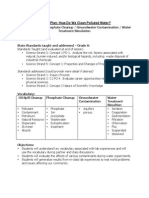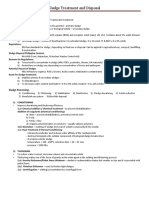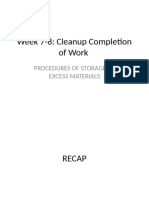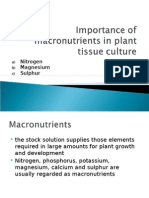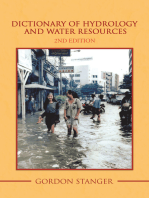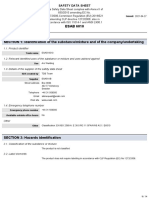Fertelizer
Fertelizer
Uploaded by
Jake ColletteCopyright:
Available Formats
Fertelizer
Fertelizer
Uploaded by
Jake ColletteOriginal Title
Copyright
Available Formats
Share this document
Did you find this document useful?
Is this content inappropriate?
Copyright:
Available Formats
Fertelizer
Fertelizer
Uploaded by
Jake ColletteCopyright:
Available Formats
4/13/2012
Fertilization
Why Fertilize? Replenish plant nutrients to sustain optimum growth and health of the plant. Losses of nutrients occur through leaching, clipping removal, irrigation,rainfall, and volatilization Essential nutrients for plant growth: C, H, O, P, K, N, S, Ca, Fe, Mg, B, Cl, Cu, Mn, Mo, and Zn. Turfgrass requires nitrogen more than any other nutrient
Way to Remember the Elements
~Mnemonic Devices~ Macronutrients: C, H, O, P, K, N, S, Ca, Fe, Mg C HOPK'NS CaF Management Micronutrients: B, Mo, Cu, Cl, Mn, Zn B Mo Cu Cl Mn Zn Bobs Mom and Cousin Clio will manage soon
Turfgrasses require 16 (some now say 17) essential elements to grow and complete their life cycle C, H, O from air and water Remaining 13-14 from 13growing media
4/13/2012
Most standard turf fertilizers contain N-P-K and often minors such as Fe, Mg, Ca, etc. Before fertilizing you should have knowledge of: species requirement air temperature soil moisture precipitation in forecast? type of fertilizer being applied
Importance of Nutrients to Turfgrass Growth and Development N P Rooting X Shoot growth (tillers. X rhizomes, stolons) Leaf growth X Color X Establishment X (germination and seedlings) Hardiness drought heat cold Disease susceptibility X Wear tolerance X Recuperative potential X Composition of turf X X community
X X X X
4/13/2012
USGA Greens Record Sept./Oct 2003 Jim Skorulski
Many different types of Fertilizer- discussed here are the more common types of fertilizers used in golf course management! Important characteristics or facts you need to know when purchasing fertilizer: a) burn potential b) release rates -water soluble or water insoluble c) analysis d) safety of product i.e. NH4 NO3 e) cost of product f) environmental concerns ( i.e. leaching) g) ease of handling h) spreadability
HIGHER SALT INDEX
4/13/2012
Nitrogen Fertilizers: There are three types we will discuss: I) synthetic inorganic II) synthetic organic IIb) Coated synthetic organics III) natural organic
Nitrogen taken up in two forms: NH4+ or NO3- mostly Nitrification of ammonia to nitrites to nitrates NH4+ NO2 NO3nitrosomas nitrobacter
NO3-
I) Synthetic inorganic (don't contain C) - In general characteristics of these fertilizers are: a) readily soluble in water b) available to plant almost immediately c) can cause growth flushes d) leach and or volatilize e) high burn potential f) are usually cheaper than coated or controlled release types
Examples of synthetic inorganics are: 1) Ammonium Nitrate NH4N03 - 33%N - handle with care-very explosive - high salt index 2) Ammonium sulfate NH4SO4 - 21% N - high salt index - used if careful - may be used to help lower pH 3) Potassium Nitrate KNO3 -13% K - 37%N -Product K power -good to use in fall for hardening off
4/13/2012
II) Synthetic organics- group contains both: i) water soluble and ii) water insoluble forms
i) Urea- is the primary water soluble form. a) rapid response b) high burn potential c) high N 46% d) leaches easily ii) Water insoluble forms include: a) Urea formaldehyde b) IBDU
a) Urea formaldehyde -38% N -very slow release rate - (long chain methlylene urea) -low burn potential -microbes to break it down -Allows high application rates -long lasting -reduces risk of leaching Cons: -cost -3-4 weeks before color change (no initial response)
4/13/2012
b) IBDU -made by reacting urea with isobutyraldehyde -31% N -slow release rate -2-4 weeks delay in response -very expensive -microbes have minimal effect on release rate -soil moisture particle size, and temperature influence release rate -be careful if excessive rainfall ie. July
IIb) Coated synthetic organic fertilizers- provide good initial response compared to IBDU and UF Two types - sulfur coated and polymer coated. Advantages coated materials: a) low burn potential b) no surge-release rates gradual c) ease of handling d) Minimal loss to leaching e) Long or timed duration of feeding g) Reduced labor due to reducing frequency of applications Cons a) cost b) mowers or traffic can break coating
Two types: 1) Sulfur Coated Urea (SCU) -coating = wax prill -release rates dependent on: soil temperature and water coating thickness and size of prill -20-30% released in first 2 weeks 2) Polymer Coated Urea (http://harrells.com/focus/polyon/) -urea coated in polymers (plastic) -nutrients release by diffusion and need soil moisture -soil temperature effects release rates -warmer the temperatures the faster the release-be careful in summer -Poly-on or osmocote are examples!
4/13/2012
SCU / PCU - formed by coating ureas granules with sulfur and a thin coating of sealant or polymers (wax, resins)
III) Natural Organics-Derived from animal or plant a) animal manure b) bone meal c) sewage sludge d) dried blood e) plant refuse f) seaweed extract Characteristics of organics a) slowly available N b) Usually a low N content i.e. 6% or less c) very safe non burning d) warm temperatures and microbes to break down e) cost > than synthetics
Note*- N in organics present in amine group (-NH2) it must be converted to NH4 before being taken up by plant called Ammonification: Also Nitrification=NH4------NO2-------NO3 Many common granular organic products used on golf courses two are: 1) Milorganite 6-2-0 Activated sewage sludge 2) Sustane 5-2-4 composted turkey litter
4/13/2012
Claims of manufacturers and researchers: -organics not only increase nutrient levels they have also been shown to reduce: disease activity of turfgrasses thatch build up or increase decomposition nitrate leaching(as with all slow release materials) soil compaction (this based on adding organic matter to soil) however not evident in studies of three years.
Claims by manufacturers and some researchers regarding organics: a) reduced soil compaction b) reduced thatch build up or increase decomposition c) reduced nitrate leaching d) reduce disease activity of turfgrasses
Compost derived fertilizers
Compost
Urea
Snow Mold Nitrogen or organic response?
0-05-02 etahpsohP mumuinommaiD )2 P %84-02 etapsohprepuS )1 :era secruos P nommoc owT Hp lios yb detceffa si P li o s ni eli b o m t o n P li o s ni eli b o m t o n P li o s ni eli b o m t o n P :stcaf surohpsohP :stcaf surohpsohP :stcaf surohpsohP :stcaf surohpsohP .tnempoleved rewolf dna dees ,tnemhsilbatse P.tnempoleved rewolf dna dees ,tnemhsilbatse P.tnempoleved rewolf dna dees ,tnemhsilbatse P.tnempoleved rewolf dna dees ,tnemhsilbatse P.smelborp detaler sserts dna snoitatsefni deew ,esaesid ot enorp frut tneicifed PN sa citamard sa ton era suorohpsohp ni seicneicifeD-
Phosphorous:
deficiencies show up in older leaves
found in greatest quantities in new cell growth
mobile in plant
Component of many plant proteins
Involved in metabolic processes including P.S.
Phosphorous Fertilization
Release over many weeks
4/13/2012
4/13/2012
Potassium Fertilization Potassium facts: Needed in the plant second to Nitrogen Leaches readily from sandy soils Increase wear tolerance Increase drought and heat tolerance Increase cold tolerance Increase disease tolerance
Silicon the second most abundant mineral element in soil after oxygen.
47 = xednI t aS 47 = xednI t aS O2K %44 O2K %44 -3ONK -3ONK 47 = xednI tllllaS 47 = xednI t aS O2K %44 O2K %44 -3ONK -3ONK 4OSK 6 4 = x e d nI t a S 6 4 = x e d nI t a S O K %05 O K %05 OSK OSK 64 = xednI tllllaS 6 4 = x e d nI t a S O2K %05 O K %05 OSK 2 411 =.I.S O2K %06 hsatop fo etairum-lCK :srez tref K tsom n desu secruos eerhT :srez tref K tsom n desu secruos eerhT :sreziiiilllliiiitref K tsom niiii desu secruos eerhT :srez tref K tsom n desu secruos eerhT
Silicon? Recent research with Si has shown: Positive effect on relieving stress Foliar spray potassium silicate reduced injury to wear Improved turf growth, drought and heat resistance Quality, Color, and Density increased Disease suppression
10
4/13/2012
Silicon continued:
Comments: More research needs to be done before recommendations of Si can be made Analytical tools utilized to exam soil and tissue nutrient levels for other nutrients are not readily available for Si. If future studies indicate positive responses, improving plant performance, disease reduction then Si could be a useful tool in IPM practices in turf.
eb nac srezilitref ylppa ot nehw dna etar eht gninimreteD
Determining fertilizer rate continued:
Soil texture i.e sand Time of year Soil tests Type and form of fertilizer- Slow release or fast release. (Slow release can be applied in greater quantities while soluble should be applied in lesser amounts but more frequent) Grade and SGN
:srotcaf fo yteirav a no tnedneped :srotcaf fo yteirav a no tnedneped :srotcaf fo yteirav a no tnedneped :srotcaf fo yteirav a no tnedneped
n noitazilitreF
Species Length of growing season-ie. Me. vs. N.J. Level of quality desired. Purpose turf used for (wear factors). i.e. tees v.s. fairways Cultural practices- i.e. Irrigation and clipping collection reduces nutrient reservoir in soil
11
4/13/2012
Determining Rates and Reading the Label
Complete fertilizer contains N-P-K called the grade or Items found on the bag: Percent N-P-K Weight Sources of N-P-K Other nutrients present % water soluble N % water insoluble N SGN (maybe)
analysis
% P2O5 %N % K2O
Grade
Guaranteed Analysis minimum percentage of nutrients which is displayed on the label
12
4/13/2012
83% of the total N in soluble form
Calculations
Mixed Blended
SCU prill Urea prill
4
Homogenous fertilizer each granule contains all of the nutrients
OSK OSK OSK OSK
13
4/13/2012
SGN = Size Guide Number = Basically prill size SGN determined by - the size below which 50%of the particles occur multiplied by 10. for example if 50% fall below 1.9mm then SGN = 190
Indicators that can be used to aid in determining fertilizer timing: -color -amount of clippings removed -wear of turf areas -physiological growth characteristics of turfgrass *Fertilization should not be for color alone. A knowledge of turfgrass growth is needed to figure timing. Fertilization to build up carbohydrate levels and reserves is important in helping the turfgrass plant survive stresses*
14
4/13/2012
Fall Applications N - Promote root growth > carbos. Root growth cool season grass in fall and spring
Fertilizing in September helps: a) maintain color for P.S. > in carbohydrates b) turf heal from summer stress. Dormant Fertilizing (after last mowing): a) Maintains color continues to produce carbos. b) Reduces or eliminates need for spring applications Early Spring applications No Growth flush in spring occurs without fertilizing
15
4/13/2012
Supplemental K fertilization will aid in hardening off turf before winter and helps toughen the plant in summer. Supplemental Fe will provide color while not pushing growth (usually short lived) Fertilizer Applications
Granular Applications
Types of Seeders
Broadcast- rotary type. Pros quick and easy Cons wind carries seed / fertilizer harder to get uniform coverage.
16
4/13/2012
Drop spreaders - Pros - good for small areas with borders -applies precise application
- Cons - slow and can lead to skips or over laps
1) Granular materials are available in different sizes or grades: Smaller grades are used on low cut turf this reduces mower pickup After applying water in At next mowing mow without buckets if possible
2) Liquid Applications applied through sprayer using a boom or gun usually light frequent applications most foliar absorbed
17
4/13/2012
Advantages of foliar feeding: Reduces leaching Reduces total amount of fert. Require Quick plant response The applicator is in control-reduces surges if weather conditions change ie. IBDU Full range of products applied at once I.e. Pana sea and Pro Sol! Mix with pesticides No irrigation needed Uniform Coverage Disadvantage-Short lived need frequent applications
Spreader Calibration
With granular fertilizers, initial settings on bags. Set spreader at setting listed-This is the starting This point. Then: 1) Measure and mark out a known area (say 100) 2) Place a weighed amount of fertilizer in the spreader 3) Start walking and open hopper at start line and close hopper at finish line. 4) Pour material left into bucket and weigh 5) Solve Equation
18
4/13/2012
Initial wt.-remaining wt. 100 x width of throw
__X___ 1,000sq
Adjust spreader accordingly up or down Example: measured area = 100 Width of throw = 8 Starting weight = 10 lbs. Finish weight = 5lbs.
800 sq. feet 8 100
Calibration continued: Example: measured area = Width of throw = Starting weight = Finish weight = 100 8 10lbs. 5lbs
10 - 5 100 x 8
X 1000
5 800
x 1000
800x = 5,000
X = 6.25 lbs. Fert./1000sq.
There are other methods to calibrate ie. kits are available to attach to spreaders Some pointers I recommend when calibrating a) Calibrate on hard surface???? b) The applicator should be the person walking the measured area c) Cut rates in half and go in two directions. d) Check amounts distributed to the size of areas. i.e. green size 5,000sq
19
4/13/2012
W.C.C. Practices FairwaysLate spring-with a polycoated nitrogen source 50% polyon 50%urea. A 20-5-20 at rate of 1.25lbs./1000sq. Late Sept.- 50% SCU and 50%urea 20-5-20 at rate of .75lbs/1000sq Last Mowing- 50% SCU 50%urea 20-5-20 at rate of 1.00lbs./1000sq Soluble used when spraying Roughs and surroundsGranular applications spring and fall
TeesGranular Fertilizer at the rate of .5-.75 lbs./1000 / month Materials used are either coated or methylene ureas Iron as well as seaweed extracts often added to spray tank GreensGranulars in the spring and fall total 1.5lbs./yr 1/8 lb. foliar every 10-14 days throughout growing season Organics, Fe, added to spray mix
20
You might also like
- Cambridge International AS and A Level Chemistry Coursebook Lawrie Ryan Download PDFDocument53 pagesCambridge International AS and A Level Chemistry Coursebook Lawrie Ryan Download PDFkeccaawad100% (1)
- Seaweed As Bioplastic: Research Chapter 1 and 2Document22 pagesSeaweed As Bioplastic: Research Chapter 1 and 2justin_domingo_295% (42)
- Calentador de Agua BryanDocument4 pagesCalentador de Agua BryanPatricio LescanoNo ratings yet
- Civil Questions and Answers-Other-Major-TopicsDocument39 pagesCivil Questions and Answers-Other-Major-TopicsAkd Deshmukh100% (1)
- Unit 7-8 ReviewDocument17 pagesUnit 7-8 Reviewapi-282611325No ratings yet
- Analysis of Soil, Sediments and Solid WastesDocument59 pagesAnalysis of Soil, Sediments and Solid Wastesaalias1113No ratings yet
- Engineering and Environments - Solid Wastes Pollution: Summary - This Chapter Consists of 6 SectionsDocument24 pagesEngineering and Environments - Solid Wastes Pollution: Summary - This Chapter Consists of 6 SectionsEric CheungNo ratings yet
- Lesson Plan: How Do We Clean Polluted Water?Document15 pagesLesson Plan: How Do We Clean Polluted Water?Tarun MattaparthyNo ratings yet
- Characteristics of Water and WastewaterDocument50 pagesCharacteristics of Water and WastewaterVikaas SagerNo ratings yet
- Sewage DisposalDocument6 pagesSewage Disposalrmlalitha07No ratings yet
- S Announcement 15750Document4 pagesS Announcement 15750Sarah SanchezNo ratings yet
- Environmental 2 - GLS684Document51 pagesEnvironmental 2 - GLS684maryamsiti504No ratings yet
- Mohammed Irfan - Investigatory Project Holiday Homework .Document19 pagesMohammed Irfan - Investigatory Project Holiday Homework .Jahir HussainNo ratings yet
- Project Work Chemistry Shantanu VermaDocument18 pagesProject Work Chemistry Shantanu VermaVenom SnakeNo ratings yet
- TES by Paneru CH 5, 6Document18 pagesTES by Paneru CH 5, 6SumitNo ratings yet
- EVS 2nd IA Question Bank (CSE ISE AIML AIDS)Document17 pagesEVS 2nd IA Question Bank (CSE ISE AIML AIDS)Shivani AppiNo ratings yet
- Chapter 1 Industrial Wastewater TreatmentDocument91 pagesChapter 1 Industrial Wastewater TreatmentSophie LvNo ratings yet
- Bishops Working With Nature Project InstructionsDocument4 pagesBishops Working With Nature Project Instructionsapi-263408419No ratings yet
- Chemistry Fertilizer Project 1Document6 pagesChemistry Fertilizer Project 1Sσɳυ ƘυɱαɾNo ratings yet
- Open Book: Submission Time: 12:30 PMDocument7 pagesOpen Book: Submission Time: 12:30 PMAsefa KumelaNo ratings yet
- Sludge TreatmentDocument4 pagesSludge TreatmentRicaMyrivilleArellagaNo ratings yet
- Week 7-8 Cleanup Completion of Work Procedures For Disposal of Waste MaterialsDocument29 pagesWeek 7-8 Cleanup Completion of Work Procedures For Disposal of Waste Materialsgrazielle.roncale100% (1)
- Lesson 10 Plant Nutrients - Nitrogen and SulfurDocument36 pagesLesson 10 Plant Nutrients - Nitrogen and SulfurJosue A. Sespene Jr.No ratings yet
- TLE 10 Agri Crop Prod Q2 Module 4 Week 4Document4 pagesTLE 10 Agri Crop Prod Q2 Module 4 Week 4Jess Anthony Efondo100% (5)
- Wang Et Al 2009 - Chlorella Cultivation in Different WastewatersDocument13 pagesWang Et Al 2009 - Chlorella Cultivation in Different WastewatersNixon AlfonsoNo ratings yet
- Module IIDocument61 pagesModule IIKeerti ShNo ratings yet
- Landfill LeachateDocument7 pagesLandfill LeachateChristian Mihai GNo ratings yet
- Sci Know Pitch 2Document13 pagesSci Know Pitch 2Gwyneth MarañaNo ratings yet
- Sewage Treatment Project: College of Engineering and TechnologyDocument6 pagesSewage Treatment Project: College of Engineering and TechnologyGolisa RobaNo ratings yet
- Constructed Wetlands: Kim Garcia, Donna King, Matt Kluvo, Kendrick Wilson and Desale ZeraiDocument47 pagesConstructed Wetlands: Kim Garcia, Donna King, Matt Kluvo, Kendrick Wilson and Desale ZeraiMartin AlvinNo ratings yet
- Lesson 4 - Evaluation Parameters For WastewaterDocument14 pagesLesson 4 - Evaluation Parameters For Wastewatermiguelrhoi.sumayloNo ratings yet
- Solid Waste Management FinalDocument46 pagesSolid Waste Management FinalMeghna RcNo ratings yet
- 4-5 Strategies For The Remediation of Lead Contaminated SoilDocument4 pages4-5 Strategies For The Remediation of Lead Contaminated SoilShuCiNgNo ratings yet
- Management of Food Waste 2 MarkDocument18 pagesManagement of Food Waste 2 MarkAksharaa JayabalanNo ratings yet
- Topic 3Document3 pagesTopic 3Janine YongcoNo ratings yet
- Solid waste managementDocument10 pagesSolid waste managementskishangowda777No ratings yet
- EEN 3701 Theme 5 Solid Waste Seperation and Processing Rev01 S12023Document18 pagesEEN 3701 Theme 5 Solid Waste Seperation and Processing Rev01 S12023AugustineNo ratings yet
- Leaching 230130113403 31f6ce4bDocument21 pagesLeaching 230130113403 31f6ce4bمحمد عليNo ratings yet
- UNITV6Document12 pagesUNITV6api-3758209No ratings yet
- PP32 Solid Waste 1471879085Document64 pagesPP32 Solid Waste 1471879085starboykenshinNo ratings yet
- Fertilizer Note For 400level StudentsDocument17 pagesFertilizer Note For 400level StudentsDennis JosephNo ratings yet
- Question 4-Waste Generated in PlantDocument3 pagesQuestion 4-Waste Generated in PlantPoovanaan Sathiya SeelanNo ratings yet
- Waste Production, Problems and PreventionDocument31 pagesWaste Production, Problems and PreventionMuhammad IrshadNo ratings yet
- Chemistry Project FileDocument16 pagesChemistry Project FileManoj Kumar100% (3)
- Earth-Science11 Q1 Module-7 Teachermade Week7Document9 pagesEarth-Science11 Q1 Module-7 Teachermade Week7manansalastarringNo ratings yet
- WMSF 13Document24 pagesWMSF 13maryanaNo ratings yet
- EIA Assignment 1Document4 pagesEIA Assignment 1hebahesham.12.2000No ratings yet
- Lecture 17 - Control & Management of Industrial WasteDocument15 pagesLecture 17 - Control & Management of Industrial WasteAshhad ShafiqueNo ratings yet
- Waste Management 1Document16 pagesWaste Management 1rbanandNo ratings yet
- Biogeochemical Cycles - 1: Class Lecture GoalsDocument21 pagesBiogeochemical Cycles - 1: Class Lecture GoalssunilkumarNo ratings yet
- Chapter MergedDocument21 pagesChapter Mergedsonireshu2222No ratings yet
- Al Hameedi2020Document15 pagesAl Hameedi2020Anissa Dafa KamilaNo ratings yet
- Topic: Composting (Lecture 3) : National University of Science and TechnologyDocument27 pagesTopic: Composting (Lecture 3) : National University of Science and TechnologyprincekamutikanjoreNo ratings yet
- Macronutrients in Plant Tissue Culture (N, MG, S)Document32 pagesMacronutrients in Plant Tissue Culture (N, MG, S)bukankhadam100% (1)
- Dr. Rajendra Gode Institute of Technology & Research.: Hazardous Waste ManagementDocument21 pagesDr. Rajendra Gode Institute of Technology & Research.: Hazardous Waste ManagementharcascNo ratings yet
- Chapter 10Document15 pagesChapter 10Bashar DaoudNo ratings yet
- Sludge Management Fog Management Land Discharge of WastewaterDocument18 pagesSludge Management Fog Management Land Discharge of WastewaterNeil RyanNo ratings yet
- Lecture 1-Wastewater Treatment TechnologyDocument164 pagesLecture 1-Wastewater Treatment TechnologyHussein KingaziNo ratings yet
- GESC1160 Final Notes1Document18 pagesGESC1160 Final Notes1ntshpresleyNo ratings yet
- Water-Pollution-ControlDocument213 pagesWater-Pollution-ControlShunilla ChimbuinheNo ratings yet
- Relative Resource ManagerDocument39 pagesRelative Resource ManagerJake ColletteNo ratings yet
- Water SlidesDocument23 pagesWater SlidesJake ColletteNo ratings yet
- Plant Growth Regulators (PGR'S)Document6 pagesPlant Growth Regulators (PGR'S)Jake ColletteNo ratings yet
- ControlersDocument7 pagesControlersJake ColletteNo ratings yet
- Golf Course Maintenance FacilitiesDocument13 pagesGolf Course Maintenance FacilitiesJake ColletteNo ratings yet
- Irrigation Valves: Electric Valves Electric Diaphragm ValveDocument9 pagesIrrigation Valves: Electric Valves Electric Diaphragm ValveJake ColletteNo ratings yet
- Pipe Breakage - Fitting Breakage - Sprinkler DamageDocument4 pagesPipe Breakage - Fitting Breakage - Sprinkler DamageJake ColletteNo ratings yet
- Water Application and UniformityDocument20 pagesWater Application and UniformityJake ColletteNo ratings yet
- The International Customs JournalDocument495 pagesThe International Customs Journaldrin_kaNo ratings yet
- MSDS GlycolDocument15 pagesMSDS GlycolJagan NNo ratings yet
- Mayonnaise Lab ReportDocument6 pagesMayonnaise Lab Reportapi-298392554100% (2)
- Presentation: Name Roll NoDocument12 pagesPresentation: Name Roll NoHamza AhmedNo ratings yet
- Buffer Pass Unit-H1 PC Rev0 022212Document30 pagesBuffer Pass Unit-H1 PC Rev0 022212techwisekgNo ratings yet
- Honey Commission InternationalDocument62 pagesHoney Commission Internationallevsoy672173No ratings yet
- Checal 2 Module ProblemsDocument3 pagesChecal 2 Module Problems5zywgtdkw5No ratings yet
- WPS 01Document2 pagesWPS 01ZaidiNo ratings yet
- C14 Water Project - AnswersDocument8 pagesC14 Water Project - Answerskennethbird23No ratings yet
- Admixture TrainingDocument63 pagesAdmixture Trainingabdul muqsit100% (1)
- Sizing Your Grease Trap or InterceptorDocument3 pagesSizing Your Grease Trap or InterceptorMike Mor'zNo ratings yet
- 000152883Document301 pages000152883Yuwono WibowoNo ratings yet
- BILSTEIN - WNB - 880 Materials and SubstancesDocument7 pagesBILSTEIN - WNB - 880 Materials and SubstancesRoberto AlvarezNo ratings yet
- International Standard: Radiation Protection - Sealed Radioactive Sources - Leakage Test MethodsDocument16 pagesInternational Standard: Radiation Protection - Sealed Radioactive Sources - Leakage Test MethodsMichael SkrableNo ratings yet
- CalculusDocument7 pagesCalculusFaikar Ardhan ArganagaraNo ratings yet
- Troubleshooting Hot Gear DrivesDocument8 pagesTroubleshooting Hot Gear DrivesYuda SatriaNo ratings yet
- IS 1893 (Part-4) 2015Document31 pagesIS 1893 (Part-4) 2015jacs12770% (10)
- Paper - Arco Channelview Texas Explotion 1990Document12 pagesPaper - Arco Channelview Texas Explotion 1990Ruby0% (1)
- Study of Metallography StructureDocument8 pagesStudy of Metallography StructureMahrukh JavedNo ratings yet
- Chapter 3 GasesDocument44 pagesChapter 3 GasesUzair AshrafNo ratings yet
- Routine Gmaw Student TaskDocument8 pagesRoutine Gmaw Student Taskapi-200253170No ratings yet
- ESAB 6010: Safety Data SheetDocument14 pagesESAB 6010: Safety Data SheetHusam AhmedNo ratings yet
- Aqa Y2 P2 Jun 19 MSDocument19 pagesAqa Y2 P2 Jun 19 MSestee.onyeNo ratings yet
- Failures of AmalgamDocument14 pagesFailures of AmalgamPriyaancaHaarshNo ratings yet
- Surface Chemistry Surface ChemistryDocument53 pagesSurface Chemistry Surface Chemistrymoses owinoNo ratings yet
- ΔHmix 2Document11 pagesΔHmix 2Nohan JoemonNo ratings yet
- 2015 - Rectorseal Plumbing CatalogDocument64 pages2015 - Rectorseal Plumbing CatalogNelson VielmaNo ratings yet
- Whirpool HeaterDocument15 pagesWhirpool HeaterWestNo ratings yet








